 |
| Edition I |
鶏頭に赤蜻蛉 [adapted title]
keitou ni akatonbo
Cockscomb and Red Darter Dragonflies
ケイトウにアカトンボ
Original Number / 原番号
113
Theme Identification / 画題識別
113 Cockscomb Theme
113 鶏頭(ケイトウ)画題
ADDITIONAL NOTES FOR THIS DESIGN
This design is the thirteenth of thirty-six woodblock prints in Rakusan's second main sequence series, 篁子生画選, Koushisei Gasen, lit. 'Koushisei's Print Selection' (usually called here the 36 Series). Rakusan originally labeled this design number 13. However, after 1936 reprinting two series with duplicated numbering caused some confusion. To avoid further problems Rakusan decided to extend the numbering system from the preceding 100 Series into the 36 Series, and this design was relabeled as number 113, the 113th design published in his main sequence. Rakusan occasionally wrote his identification number in pencil on the reverse of the print.
Currently Documented Edition Signature and Seal Markings:
| Edition I: | 楽山篁子生 | Raku-zan Kou-shi-sei | + Seal B |
[For illustration of seals listed by seal code letter, see the Seals article. For edition and dating characteristics applicable to the entire series, see the Editions article.]
Print History:The woodblock print of 113 was adapted from 113-0, an actual-size original painting on silk. Because Rakusan intended to retain all of the 36 Series prototypes in his personal collection, he did not affix a signature or seal, and the silk remained loose and unmounted. The silk was originally a pale cream color, but over time it has significantly yellowed:
 |
| 113-0 (original painting on silk, collection of the artist) |
Edition I (1934-1941): Like most 36 Series designs 113 has the same signature and seal combination on every copy. Because all documented copies of 113 once looked very much alike, and are often associated with presentation sheets (see below), they are all referred to the original edition I printings. Unfortunately, in printing 113 Rakusan used a red-violet pigment which is subject to sun fading (probably an organic madder lake), and some copies have been badly damaged. The original painting 113-0 has discrete bands of golden glitter across a background of a rich golden tan. In adapting the woodblock print 113, Rakusan interpreted these as bands of a solid, pale wash with no glitter on a much paler background color. There is currently no evidence for any other versions of 113. The copy illustrated above is typical of edition I.
The earliest 36 Series prints were delivered tipped into recessed wells of presentation sheets embossed in their lower margins with the series title. Because all early edition I prints once had these presentation sheets, a copy which retains its presentation sheet must have been printed during the 1930s. After his supply of presentation sheets was exhausted, Rakusan distributed subsequently-reprinted copies loose. A limited number of leftover earlier-printed copies of some designs on presentation sheets were still being distributed shortly after World War II, but by then most designs were only available as loose sheets. However, absence of presentation sheets is not diagnostic of later printings because many early prints have subsequently been detached from theirs.
Theme History:The Rakusan project which produced 篁子生画選, Koushisei Gasen, resulted in two related series of woodblock prints. Each print of the 36 Series is intimately connected to a group of prints with the same subjects in the Fan Series. Together these subject-related prints in the two series constitute a theme. Each theme consists of a quintet of monochrome Fan Series designs (one design in each of the five fan shapes), plus one polychrome, 36 Series design which illustrates the theme subject. The theme is labeled here by the original Rakusan number of its 36 Series design followed by the subject. 113 is the 36 Series design of the 113 Cockscomb theme.
The 113 Cockscomb theme is one of the many entirely regular themes represented by a complete fan quintet and a color woodblock print. Four of the five Fan Series designs have seal C which indicates carving dates between the last months of 1933 and the end of the first quarter of 1934. However, the 36 Series design 113 and the remaining Fan Series design have seal B which indicates a later carving period closer to the time of publication.
On the Fan Series delivery folio for installment four on June 25, 1934 Rakusan announced the designs due to appear in installment five the following month, July 1934. However, a different theme had been announced as 113, and the cockscomb designs were apparently a last minute substitution for this position in the publication order for installment five. The delivery documents for installment five have yet to be located, and it is not known if installment five was actually distributed on time or was delayed. The publications of installment four in June 1934 and of installment six in September 1934 constrain the publication of installment five to one of the two intervening months, July or August 1934, and indicate that the other month had no delivery. The woodblock prints for installment five would have been printed during the same month as their distribution.
The name used here for the 113 Cockscomb theme is a literal translation of 鶏頭, keitou, upon which the Japanese names for not only all varieties of cockscombs, but also for amaranths and other members of the Amaranth Family, are based. The six designs of the 113 Cockscomb theme include four crested cockscombs, one plumed cockscomb, and a tricolor amaranth. Therefore, the theme is related not only to the crested cockscomb design 35 of the earlier 100 Series, but also to the tricolor amaranth design 55. At least some 113 Cockscomb theme designs were adapted from sketches originally created in the late 1920s for those earlier large designs (see below).
Species Illustrated:Although not native to Japan, cockscombs and the related amaranths are old garden imports which for centuries have been extensively bred and hybridized by Japanese horticulturalists. These plants were favorite subjects for Rakusan and several diffferent kinds appear in his prints and paintings. The general name for the group is also the species name of the crested version of cockscomb (sometimes simply called cockscomb), Crested Cockscomb, Celosia (argentea var.) cristata, 鶏頭, けいとう, ケイトウ, kei-tou, lit. 'chicken-head'. Crested Cockscomb is the variety Rakusan illustrates not only in 113, 35alt, and 35; but also in three of the fan designs in the 113 Cockscomb theme.
The general name for all dragonflies is 蜻蛉, とんぼ, トンボ, tonbo, 'dragonfly'. This name is also used in a technical sense for members of the huge, cosmopolitan family Libellulidae which are often called skimmers in English. The only dragonflies Rakusan includes in any of his woodblock print designs are medium-sized skimmer dragonflies. Many Japanese species of skimmer dragonfly have transparent wings with a small rice-grain-shaped dark spot on the leading edge of each wing near the outer end. This feature can be seen in all of the Rakusan woodblock print images of dragonflies.
Several kinds of skimmer dragonflies in the genus Sympetrum (also called darters in English) have males with red bodies and therefore are informally known as 茜(蜻蛉), あかね(とんぼ), アカネ(トンボ), akane (tonbo), lit. 'madder-red (dragonfly)'; or 赤蜻蛉, あかとんぼ, アカトンボ, aka-tonbo, lit. 'red dragonfly'. However, although the bodies of the red darter males are solid red, the bodies of the females (and those of many other skimmers) are yellow with brown or black stripes, bands, or other markings.
The only secure identification of a Rakusan dragonfly species is a red darter dragonfly illustrated in the 36 Series design 113. This species, Sympetrum baccha matutinum, lacks a common name in English. Its Japanese name is 小熨斗目蜻蛉, このしめとんぼ, コノシメトンボ, ko noshime-tonbo, lit. 'small noshime dragonfly'. (A noshime is a kind of ceremonial dress.) It differs from the other red darters in having a dark red-brown or black patch covering the entire outer end of each transparent wing (instead of just the small spot). However, presumably for easier printing, Rakusan took artistic license in depicting this species in 113. He used the same magenta reds which predominate in the cockscomb flowers for the dragonfly bodies (making them appear male), and also for the large wing tip patches. As a result, the small dark spot which would in life have merged with the darker wing tip patches is still visible.
In addition to the dragonfly in the 36 Series design 113, two Fan Series designs in the 113 Cockscomb theme also include skimmer dragonflies. However, neither these two (nor any other Rakusan dragonflies) can be the same species as in 113, but other identification is largely speculative. There are five other skimmer dragonflies which occur in monochrome fan designs; so only the patterns (if any) are available for identification. 113-2 and 133-5 are simple line drawings which lack further diagnostic details. 113-4 and 106-4 have markings on the body that suggest those skimmers are female, and the solid color body in 128-1 suggests a male. All of these other examples could be any of several closely similar skimmer species. One representative red darter candidate would likely have appealed to Rakusan since it is a common endemic, Autumn Darter, Sympetrum frequens, 秋茜, アキアカネ, aki akane, lit. 'autumn madder-red'. Another possibility would be a skimmer species in the genus Orthetrum such as Common (White-tailed) Skimmer, Orthetrum albistylum speciosum, 塩辛蜻蛉, シオカラトンボ, shiokara tonbo, lit. 'salt-spicy dragonfly'.
Related Designs:
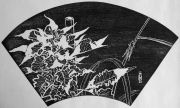
|
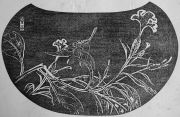
|
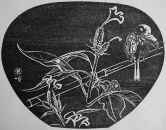
|
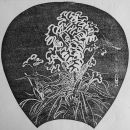
|
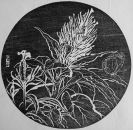
|
| 113-1 | 113-2 | 113-3 | 113-4 | 113-5 |
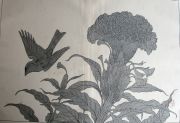
|
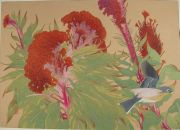
|
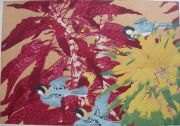
|
| 35alt | 35 | 55 |
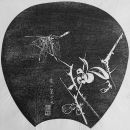
|

|

|
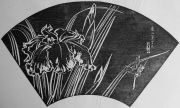
|
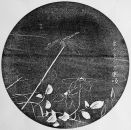
|
| 106-4 | 113-2 | 113-4 | 128-1 | 133-5 |